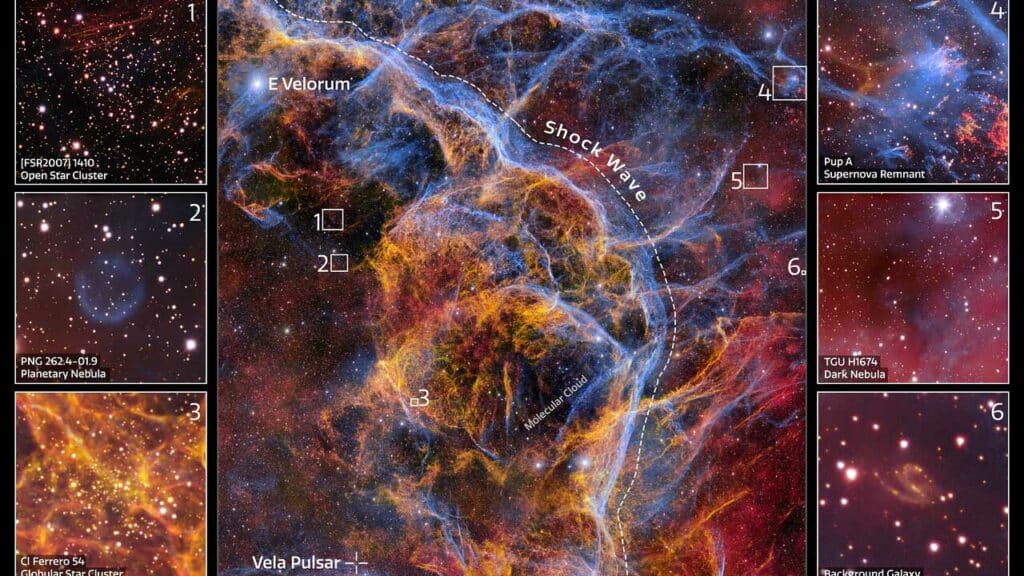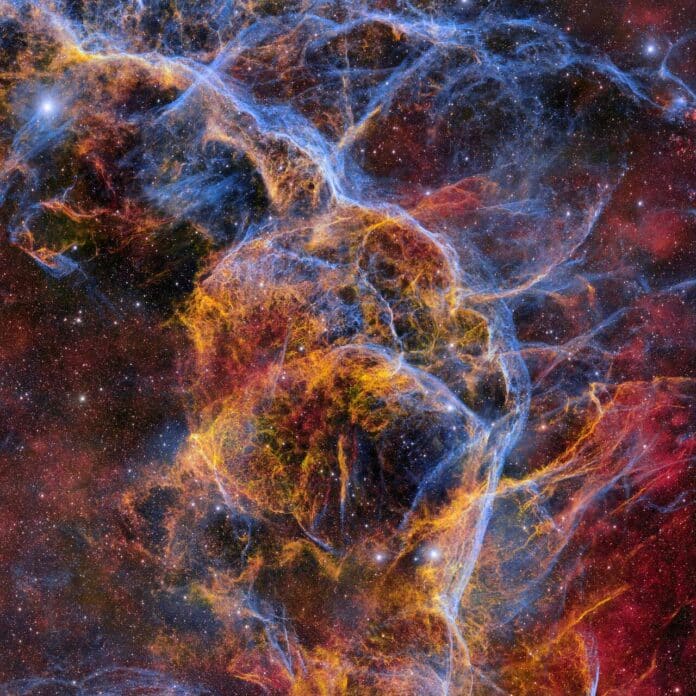Using the powerful Dark Energy Camera (DECam), astronomers have produced a large 1.3-gigapixel image that highlights the center region of the Vela Supernova Remnant. This remnant is left over from a massive star that went supernova around 11,000 years ago. This image was taken by the DECam, which is installed on the Víctor M. Blanco 4-meter Telescope at Cerro Tololo Inter-American Observatory, part of the US National Science Foundation.
Situated in the constellation Vela, sometimes known as the Sails, the Vela Supernova Remnant is approximately 800 light-years from Earth. It is a wispy gas filament nebula made of cosmic debris expanding from the explosion. The explosion’s source star died billions of years ago, but the shockwave it produced is still making its way across space, bringing incandescent gas tendrils with it.
This is one of the most significant pictures of the Vela Supernova Remnant. The image was captured using the state-of-the-art Dark Energy Camera (DECam) installed on the 4-meter Víctor M. Blanco Telescope of the US National Science Foundation at Cerro Tololo Inter-American Observatory in Chile.

Three distinct DECam filters, each collecting a different light color, were used to generate the image’s brilliant colors, including reds, yellows, and blues. This high-resolution color image, produced by combining individual photographs captured with each filter, highlighted the complex web-like filaments within the enlarging gas cloud.
The Vela Supernova Remnant is one of the remnants of a huge star that burst some 11,000 years ago. The blast tore apart the star’s outer layers with such force that it left a shockwave still reverberating across space. This shockwave creates the stringy blue and yellow filaments visible in the picture as it interacts with the interstellar medium around it.
The Vela Supernova Remnant is a massive structure that stretches nearly 100 light-years and reaches twenty times the diameter of the full Moon in the night sky. It is a stark reminder of the star’s explosive demise.
The star ended dramatically, but not before leaving behind the Vela Pulsar, a relic. This remnant is a neutron star, a dense object created when the star’s core imploded. With the mass of the Sun, the Vela Pulsar is about the size of a metropolis and is compressed into a sphere that is only a few kilometers across. Situated in the lower left section of the picture, it seems faint compared to its neighboring celestial bodies. On the other hand, it has a strong magnetic field and spins quickly on its axis, producing twin radiation beams that travel across the sky eleven times per second, much like a lighthouse bulb.
This picture, taken with the Dark Energy Camera (DECam), demonstrates the fantastic powers of the device. DECam, fixed atop the Blanco telescope in Chile, captures light from all throughout the universe. Light enters the telescope and bounces off a huge mirror before hitting 62 charge-coupled devices (CCDs) arranged in a grid after going through a correction lens. The CCDs in the camera function as its “eyes,” transforming incoming light into electrical signals and subsequently translating those signals into pixels.
DECam produces images with an incredible 570 megapixels each shot. Astronomers can obtain astonishing detail by stacking many exposures. Thanks to DECam’s massive mosaic of charge-coupled devices (CCDs), a wide starscape is available for investigation, enabling scientists to produce intriguing photographs of weak astronomical objects like the Vela Supernova Remnant.
